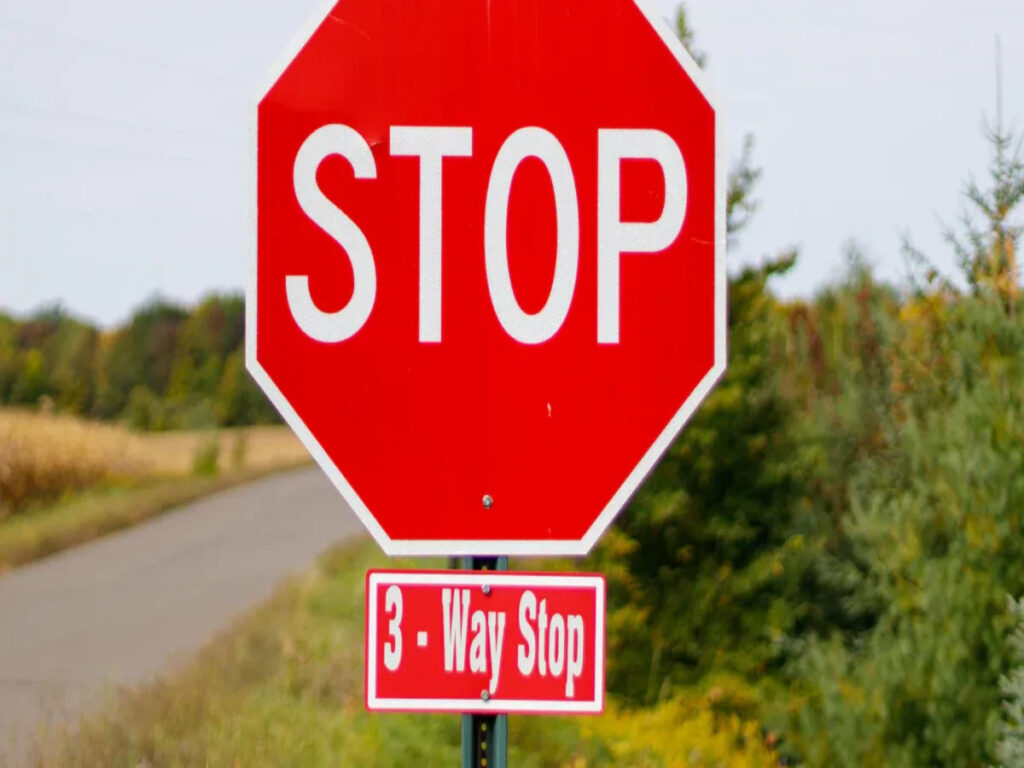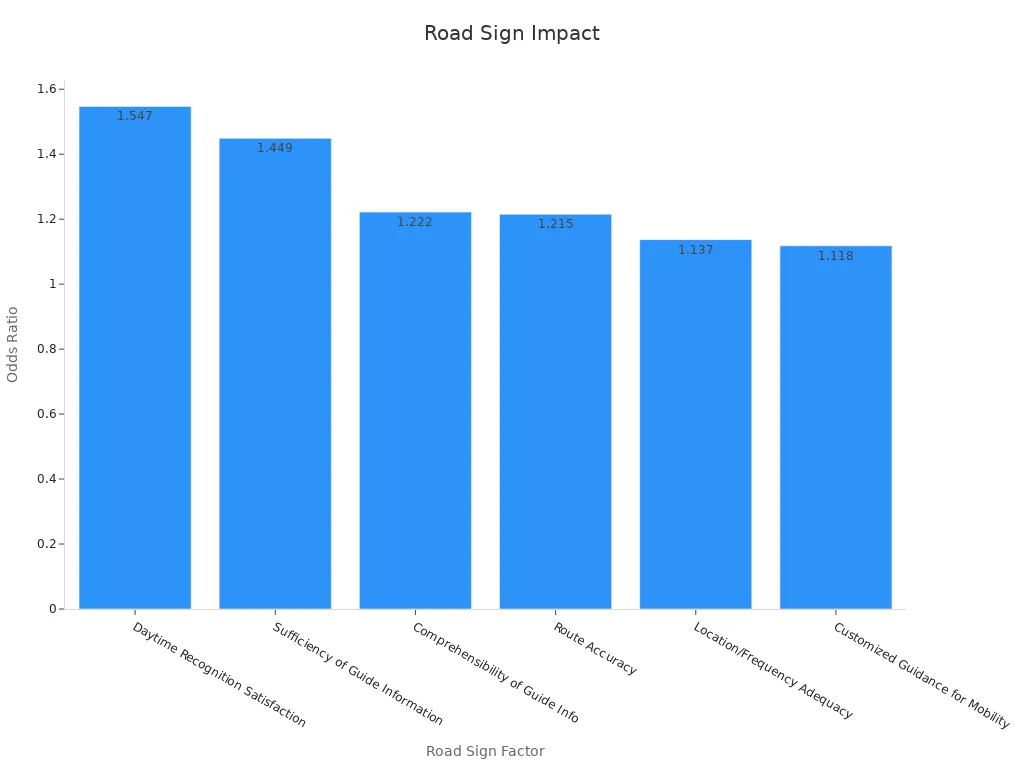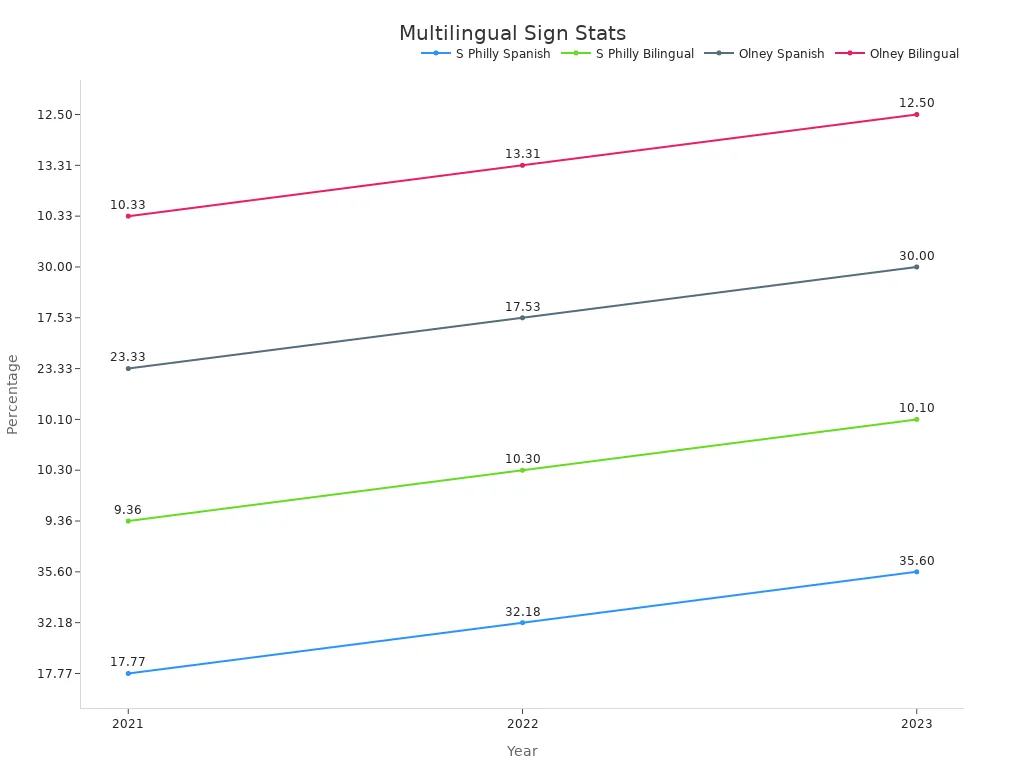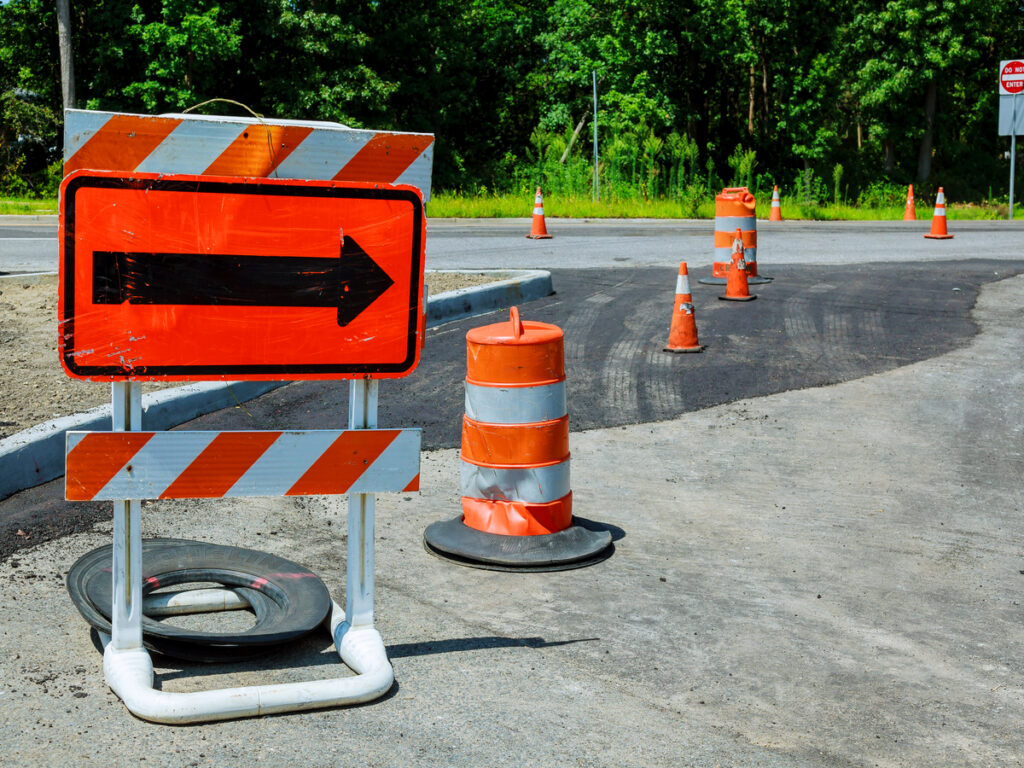
Você usa sinais de trânsito todos os dias para ajudá-lo a se manter seguro nas estradas. Clear road sign language is very important for safety. It gives you simple instructions and helps stop confusion. When signs use easy words and symbols, you know what to do fast. This clear message helps stop accidents and helps drivers, ciclistas, and walkers talk to each other. Good road signs make it easy to understand what to do. Safe roads need good sign design. Good signs help you always know what to do next.
Clarity and Road Safety
Prevenção de acidentes
You count on road sign language to keep you safe. Clear signals help you react fast and avoid danger. Simple words and symbols on signs tell you what to do. This helps you even when you feel stressed. Direct messages from signs help stop accidents and make roads safer for all.
Many studies say clear road signs lower confusion and cut accident rates. Por exemplo, better signs and good visibility at intersections mean fewer dangers. The table below shows how different sign improvements can help stop crashes:
| Signage Improvement | Crash Type Addressed | Fator de redução de acidentes (CRF) |
|---|---|---|
| Enhanced signing and delineation at intersections | Right-angle and rear-end crashes | 40% |
| Improved maintenance of stop signs | Right-angle crashes | N / D |
| Stop bar on minor road approaches | Right-angle crashes | 19% |
| Supplementary stop signs over the roadway | Right-angle and rear-end crashes | 19% |
| Flashing beacons at stop-controlled intersections | Right-angle and rear-end crashes | 12-58% |
Better signs mean fewer crashes. Flashing beacons at intersections can lower some crashes by up to 58%. High-contrast and Sinais reflexivos help you see better. This lets you spot danger sooner and react in time. Em zonas escolares, LED flashing signs help drivers slow down. This keeps kids safer and protects people walking.
Research also shows that clear road sign language makes driving safer. The chart below shows how different road sign factors affect your safety:

You are safest when signs are easy to spot, give enough information, and are placed where you need them. All these things help stop accidents and make roads safer.
You can see the results of clear signs in real life. Speed feedback signs in fast zones can lower speeds by up to 16 km/h. Slower speeds mean less serious crashes and more time to react. National studies show crash rates drop by 5% para 7% after these signs go up. Quando você vê claro, well-placed signs, you make safer choices and help keep others safe.
Immediate Comprehension
Quick understanding is very important for road safety. When you see a road sign, you need to know what it means right away. Good signs use simple words and symbols you know. This saves time and helps you avoid danger. It also keeps traffic moving well.
Studies show unclear signs cause confusion and unsafe moves. If you see a sign with confusing words or symbols, you might pause or make a mistake. O Manual sobre Dispositivos Uniformes de Controle de Tráfego (MUTCD) says to use short, standard phrases. This helps you get important information fast. Testing signs for readability and not using hard words also helps.
Research proves that quick understanding matters. Em um estudo, people understood clear messages like “You can Cross” ou “Do not Cross” better than hard-to-understand icons. Sinais como “Road works” ou “Sem inversão de marcha” had over 90% entendimento. This means you react best to signs with clear, direct words.
The table below shows how good sign design helps you understand signs right away:
| Finding Aspect | Detalhes |
|---|---|
| Participants | 30 Taiwanese and 30 Vietnamese users, gender-balanced |
| Training Conditions | Before training, immediately after training, one month after training |
| Comprehension Scores (Taiwanese) | Antes: 0.63; Immediately after: 0.98; One month after: 0.83 |
| Comprehension Scores (Vietnamese) | Antes: 0.41; Immediately after: 0.89; One month after: 0.66 |
| Key Design Features | Semantic closeness, concreteness, and meaningfulness highly correlated with comprehension |
After training, people understood signs much better and remembered them for at least a month. Signs that match what you expect help you understand faster and remember longer.
You also do better with signs you see often and know well. The more you see the same design and words, the faster you react. This sameness in road sign language helps you understand quickly and avoid crashes.
Dica: When you drive or walk, always look for clear and familiar signs. They give you the important information you need to stay safe and avoid danger.
By making signs clear and easy to understand, road signs help stop accidents, Torne as estradas mais seguras, e proteja a todos.
Design for Clarity
Simple Language
You must read road signs fast when near traffic. Simple words on signs help you react quickly. Studies show clear words make signs easier to read. This helps you stay safe, even if you feel worried. Fewer words and letters on signs make them easy to see. Sinais como “PARAR,” “COLHEITA,” e “Zona escolar” use clear words. These signs warn you or tell you what to do. Designers check sign length and how easy it is to read. They make sure signs are safe for everyone. When you see simple words, you know what to do right away.
Symbols and Visuals
Symbols and pictures are important in road sign design. You often see warning signs with bright shapes and colors. A red octagon means “PARAR.” A yellow triangle warns about danger ahead. Studies show bright colors and known icons help you notice signs fast. Adding short words to symbols, como “Sem inversão de marcha,” helps you remember them. The table below shows how well people understand different symbols:
| Symbol Example | Comprehension Level (%) | Notes on Design Principles |
|---|---|---|
| Road works | Sobre 90% | Consistent, ergonomic design |
| Sem inversão de marcha | Sobre 90% | Standardized, fácil de reconhecer |
| Narrow bridge | 44% para 85.6% | Better with familiar design |
| Wheelchair crossing | 44% para 85.6% | Familiar, clear for all users |
| Reverse curve | 44% para 85.6% | Improved with standard visuals |
Clear signs with good pictures help you see warnings from far away. Good sign design uses space, tamanho, and color to help you see the message.
Consistência
Keeping road signs the same helps you stay safe. When road safety signs use the same shapes, cores, and letters, you learn what they mean. Studies show that using the same design makes signs easier to spot. It also helps you react faster. Warning signs are yellow and black. Informational signs are blue or green. This helps you know what kind of message you will see. Using big letters and strong colors helps people with vision problems. When signs follow these rules, you get clear warnings and directions every time you travel.
Dica: Watch for the same shapes and colors on road signs. They help you spot warnings and information fast, Mantendo você e outros seguros.
Multilingual Road Signs and Inclusivity
Quebrando barreiras linguísticas
Many people use U.S. roads every day. Some do not speak English as their first language. Multilingual road signs help everyone understand directions and warnings. These signs make travel safer for all, including tourists and new residents.
The table below shows why these signs are important. Os EUA. has many different people. Some workers were born in other countries. They may speak other languages. OSHA says signs must be in English and the main language of workers. Multilingual signs can lower job accidents by 25%.
| Demographic/Statistic | Percentage/Detail |
|---|---|
| Foreign-born workers in U.S. workforce | 17% (may speak languages other than English) |
| Workforce racial/ethnic composition | 77% Branco, 19% Latino, 13% Preto, 7% Asiático |
| OSHA accident reduction with multilingual signage | 25% fewer job-related accidents |
| Regulamentos da OSHA | Require signs in English and main workforce language |
Some neighborhoods now have more Spanish and bilingual signs. This helps more people feel safe and included. In places like South Philadelphia and Olney, these signs have increased over time.

Some Native American tribes in New York use signs in English and their own languages. These signs help keep culture alive and show respect for tribal lands. Multilingual signs help everyone talk and feel welcome.
Observação: When you see bilingual signs, you help make the area friendly and safe for all.
Símbolos Universais
Symbols on road signs help you understand fast. You do not need to know the language. A red octagon always means “PARAR.” A yellow triangle warns about danger. These shapes and colors are a code you learn to trust.
- Symbols everyone knows help you react quickly.
- Red means stop or danger. Blue gives information. Yellow warns you.
- Symbols help you stay safe, even if you are new to the area.
- Research shows you see symbols faster than words, especially when stressed.
- Shapes and colors you know help you remember what signs mean.
Multilingual signs and clear symbols work together. They help everyone get the right information and stay safe on the road.
Legal and Psychological Impact
Conformidade e padrões
Road signs in the U.S. must follow strict rules. These rules make sure signs are clear and safe. O manual em dispositivos uniformes de controle de tráfego (MUTCD) Define essas regras. A tabela abaixo mostra os pontos principais:
| Aspecto | Descrição |
|---|---|
| Legal Basis | Manual sobre Dispositivos Uniformes de Controle de Tráfego (MUTCD) |
| Five Basic Requirements | 1. Fulfill a need 2. Command attention 3. Convey a clear, simple meaning 4. Command respect 5. Provide adequate time for response |
| Sign Classes | Regulatório, Aviso, Guia |
| Sinais regulatórios | – Communicate laws and regulations – Cores: preto, branco, vermelho – Must be repaired/replaced within hours if damaged or missing – Exemplos: PARAR, COLHEITA, MÃO ÚNICA, NÃO ENTRE |
| Sinais de aviso | – Alerte os motoristas sobre perigos – Cor: fundo amarelo – Repair/replacement within 3 days of notice |
| Sinais Guia | – Assist navigation (route designations, destinations, serviços) – Cores: usually white on green, also brown or blue – Include street names, route signs, hospital symbols, etc.. |
| Manutenção & Colocação | – Decisions based on engineering judgment or studies – Local jurisdictions advised to seek expert assistance if needed |
| Acessibilidade & Policy | Federal policies on accessibility and civil rights support clear and accessible signage standards |
Signs must also follow the Lei dos Americanos com Deficiência (Ada). ADA rules say signs need Braille, alto contraste, and correct height. Sobre 40% of ADA problems are because of sign mistakes. These mistakes include missing Braille or signs in the wrong place. Desde 2016, more people have sued about sign problems. As multas podem ser $75,000 for the first mistake and $150,000 for more. Clear signs help about 10 million people with vision problems. Following the law keeps you safe from big fines.
Observação: Quando você segue estas regras, you help everyone travel safely and avoid legal trouble.
Behavior and Decision-Making
You make better choices when signs are clear. Stress and confusion can cause mistakes on the road. Studies show stress and worry cause most crashes. Human error, often from stress, leads to about 94% of accidents. Clear signs help lower your stress and help you decide faster.
Mobile message signs give you updates right away. These road signs help you feel calm and in control. You drive safer when you trust the signs you see. Grande, brilhante, and simple signs are easy to spot. If a sign has too much information, you might slow down or get confused. Eye-tracking studies show simple signs help you focus and react quickly.
Signs should match your speed and how much you need to know. Too many or too few signs can make you feel stressed. Good sign design makes it easier to make safe choices, even when you feel rushed or worried.
Clear road sign language keeps you safe every day. Simple words and symbols help you understand what to do fast. Inclusive signs make roads safer for everyone.
- Support signs that use easy language and clear symbols.
- Watch for signs that need fixing or updating.
- Learn about the rules that keep signs safe and fair.
Lembrar: Sinais claros salvar vidas. You help make roads safer by caring about good signs.
Perguntas frequentes
What makes a road sign easy for you to understand?
You understand a road sign best when it uses simple words, símbolos claros, and bright colors. Familiar shapes and short messages help you react quickly and stay safe.
Why do you see the same shapes and colors on many road signs?
You see the same shapes and colors because they help you recognize the sign’s meaning fast. Por exemplo, vermelho significa parar ou perigo. Yellow warns you about hazards. This consistency keeps you safe.
How do road signs help people who do not speak English?
Multilingual signs and universal symbols help everyone. You can follow directions even if you do not read English. Symbols like arrows or a red octagon mean the same thing in any language.
What happens if a road sign does not follow legal rules?
Se um sinal quebrar as regras, you might get confused or unsafe. The law requires clear, accessible signs. Cities can face fines if they do not fix problems. You help by reporting damaged or unclear signs.



















